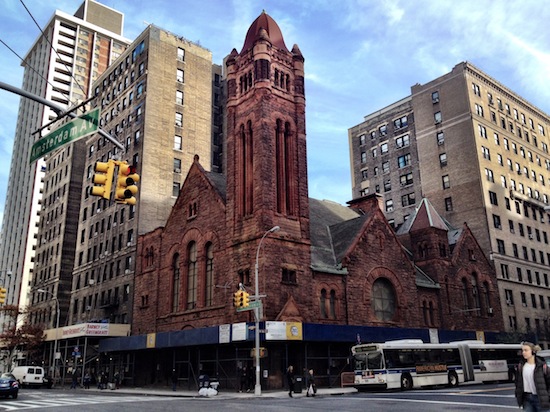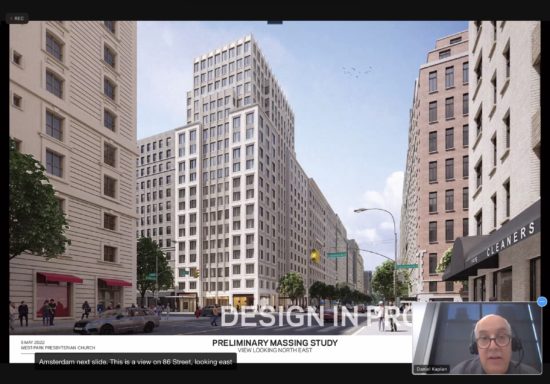
By Carol Tannenhauser
Sarah Carroll, chair of the city’s Landmarks Preservation Commission (LPC), didn’t keep attendees at Tuesday’s public hearing about the fate of West Park Presbyterian Church in suspense.
At the start of the four-hour meeting, where commissioners heard from nearly 50 people, Carroll said a decision won’t be made until later this summer about whether the 132-year-old landmarked church will remain standing or make way for a new high-rise project.

Carroll and the 10 other commissioners will go over Tuesday’s testimony, make site visits to the church and hold another session for questions and discussion in July, before making a final decision on the church’s fate. “It will be a very robust and methodical public hearing process,” she said.
That process is something of a contrast with the two Upper West Side community board meetings held this spring to consider the request of the 12-member West Park congregation, which has filed a “hardship application” to release it from its landmark designation. If landmark status is ultimately removed, the church can be sold to a developer with $33 million and a plan to raze the 19th-century building and replace it with a 19-story condominium.
Both Community Board 7 and its landmarks committee voted soundly to reject the hardship application — and thus the condo project. But their votes were only recommendations to the Landmarks Commission, which has the final authority in the matter.
And the testimony before the LPC on Tuesday was less lopsided than what the community board members had heard earlier. Where almost every presentation at the CB7 sessions had opposed the condo project, more than a dozen speakers urged the LPC to allow it — by reversing the landmark designation the panel had given the building 12 years ago.
After West Park made its presentation, and approximately 46 people testified — 33 against the plan to tear the church down, 13 who were ready for the wrecking ball — Carroll closed the hearing.
So the news is no news, but not really. This is the 11th hour for the church. City Council Member Gale Brewer and several representatives of the nonprofit that currently leases — and has offered to buy and restore it — are confident the money can be raised.
Opponents accuse them of saying the same thing 12 years ago, when the church was first landmarked.
Proponents of saving the church say un-landmarking a landmark would set a dangerous precedent and undermine the Landmarks Law.
The details of both arguments coming soon.










19th century historical landmark > soulless box of condos for the wealthy.
“But we need affordable housing!” Yeah this is not going to be that.
Keep the old church.
You keep using the buzzword ‘soulless’ to describe condos. I really don’t understand how one applies this term to an apartment. I would imagine that many of us happily live in apartments that you like to deride. Can you (or anyone) offer an explanation?
By delaying a decision, the side that wants to keep the church is basically winning. It’s all fun and games until the building falls down.
I have said it several times. If the church truly cared about the community, they would let the church be torn down and accept less money so that a smaller building and/or one that has more middle income apartments can be built there. Their goal should not be to maximize revenues.
Meanwhile, the city has a lot bigger needs than repairing this church – the money Brewer wants to raise can be used in better ways.
The building is not going to fall down between now and July of 2022.
(Yes, I can think of circumstances under when the building would “fall” in the next 6 weeks, but so would a lot of other buildings in Manhattan.)
Michael Hiller, representing the arts group, The Center at West Park, made compelling arguments that the applicant cannot show hardship. The church made no documented effort to sell air rights or seek grants from larger Presbyterian groups. The assessed value of the property, according to Hiller, is 3.5 million. The arts group offered that, but the church refused. The building is not falling down. It will not take $50 million to make it “leasable”; it’s being rented out already. This all amounts to an attempted grab by a developer. Can you imagine San Giovanni in Laterano demolished to make room for a luxury condo tower? What tourists will want to come to NYC and spend money to look at homogeneous condo towers for the rich?
WP air rights have little value since virtually everything on either side that adjoins lot is already built at full FAR. Ditto for properties across street.
Even if WP sold air rights, then you’d have another bunch of UWS residents howling in protest as this or that building(s) are slated to be torn down for redevelopment using said air rights.
Since residents from buildings on either side of WP are loudest in moaning about potential demolition and redevelopment there is an option. They can band together and buy the property, putting their money where their mouths are so to speak. It has been done before…
https://cooperatornews.com/article/chelsea-condo-owners-halt-tower-project-by-paying-11m
As for rest of it, Presbytery of New York already has provided funding to WP in past. They do not have unlimited funds, and thus cannot save everyone.
Re: “What tourists will want to come to NYC and spend money to look at homogeneous condo towers for the rich?”
1. Quite doubtful that tourists will venture up to W. 86th Street to look at ANYTHING when there is so much to see midtown/downtown (the magnificent St. Patrick’s Cathedral, St. Bartholomew’s, etc.)
2. Many tourists, especially those from smaller cities, DO enjoy our huge buildings, especially breath-taking edifices like One World Trade, Hudson Yards, Rockefeller Center, etc.
3. Besides, the proposed building IS quite different, and does NOT have a sign “for the rich”.
Show me one tourist – ONE, EVER – who said “I’m going to NYC to look at their 19th century churches. I especially want to see that amazing one on the UWS next to the lox shop, I hear it’s also been clad in scaffolding for 20 years. It’s gonna be expensive, but that’s what I want to spend money on.”
Do you normally sell your property at “assessed value”, or at market value to the highest bidder? I’d assume you can find out the price of, say, 2-bdrm, 2-bath (newish) condo on the UWS?
There are indeed countless tourists who visit to survey the architecture and use guide books and walking tours to visit many of the famous 19th century churches. A majority? Perhaps not, but many, yes.
My point about tourists is directed to the principle that one of the things that draws people to NYC is its history and the buildings that reflect that history. To decertify a landmark, the owners of which did not maintain the property and have not satisfied the requirements of proving “hardship,” will set a precedent that threatens landmarks in general. The repercussions can spread over the city. It’s not only this one building that is in play here but how the landmarks law will be applied elsewhere as well. Shall other owners be allowed to let their buildings deteriorate, fail to prove hardship, and nevertheless get a decert so they can sell to a condo developer? THAT’s the effect I am speaking against. in addition to the effects on this corner.
I understand, but therein lies the entire insufficiency and weakness of the laws. Even to a layperson like me, a landmark designation should denote something of community value beyond that to the immediate owners – something worth preserving with community resources. There should be mechanisms and constraints put in place to do that – and on time. That means activating all this brouhaha 15 or 20 years ago when it was first becoming obvious that the building is falling behind on repairs. Not letting it go until it (allegedly) requires $50mm to save. If those mechanisms exists, someone is responsible for failing us but we’re not hearing any names.
The last thing I personally want is a windfall for malicious owners (even more so for religious organizations who pay no taxes, yet dispose of enormous assets; that’s another topic), or for developers (they’ll have other chances to make money.)
None of that discussion is happening as far as I know. Even the article talks about “public hearing process” as if that’s the critical factor, not the actual details. Has anyone actually seen any engineering reports on realistic repair estimates? Does the Commission have it? The Community Board? All I I hear is harping about “condos for rich people” (as if billionaires are sitting around waiting for THAT condo), or handwringing with slogans (“save the church!”) as if that alone will raise the necessary funds.
Adding to what Ground Control says below: details about repair estimates were presented and discussed at the historic preservation committee hearing of CB7. A raft of engineering and architectural details were and are in process of being submitted to LPC. LPC announced a follow-up hearing in July so that they can go over all this stuff in the meantime.
Yes in fact there were engineers hired by the arts group within who I believe testified at the Landmarks hearing with dramatically different and much lower estimates than were claimed by the church necessary for repairs. The public hearing process is not just a bunch of people sitting around moaning. It is FULL of “actual details” from the applicant, his engineers, his lawyers, those who oppose the applicant with their experts and lawyers, and the public. You need to make yourself more informed. There is a recording of the hearing which just took place on Youtube and at the LPC’s website. As for “harping” about condos for rich people-that is a fact. Analyze all that’s being built and has just been built in the past several years on the UWS. It’s 98% for very wealthy people.
It’s about time there are some wealthy people coming into this neighborhood. Your small businesses are suffering and need to raise prices to keep up with inflation. We need more people moving in and an influx of money to help keep your local stores open. The “wealthy” are not taking over your neighborhood. It’s called a balance of all income levels.
Assessed value is tax calculation, not an actual appraisal of value. The building next door to the church just saw a 3BR apartment sell for $3.5M (https://streeteasy.com/building/161-west-86-street-new_york/4b)
No one should think that the cost of a giant corner lot on a major intersection is equivalent to the cost of a 3BR apartment. It would be like me buying your bank account for the amount you paid in taxes last year.
This church saga is becoming the Kobayashi Maru of UWS real estate. An impossible challenge to “win”, filled with unworkable magical ideas for who will find $50 million of dollars to stop a church from collapsing and bring it into ADA compliance. The only way to win is to accept the loss and move on.
This church and its ugly scaffolding has been a blight on our neighborhood for years. How people can think they have the right to deny the owners of the church their right to determine what to do with their property is pure hubris. St. Peter’s Lutheran Church made a deal with Citibank many years ago to build a new church within a larger office building. The result is a magnificent sanctuary know for jazz vespers. The church works tirelessly with seniors and is a credit to Manhattan. We could have the same: new church, event space AS WELL AS an apartment house. I just hope the Landmarks Preservation Commission has more sense than Community Board 7!
I’m all for keeping the church, IF AND ONLY IF, Gale Brewer and her bunch can come up with a VIABLE plan within six months. They should be put on the clock to come up with a restoration plan, all the funding ($20-50M depending on who you speak to), PLUS a long term sustainability plan which will require funding sources to keep the church up-and-running.
If they can’t do that, tear the church down.
As of now, Gale and her cronies are saying how “easy” it will be to raise funds – but no timeline or sources. Let them come up with it, and all will be well.
Otherwise we will have 20 more years of scaffolding.
I think everyone here is for keeping the church if the money can be raised to repair it and maintain it as going concern. I am with you up to the point that they come up with a “plan.” This is not a new problem. They should be given six months to come up with all the money necessary to do the repairs (and this is landmarked building so the costs will easily be 25-50% higher than regular repair). Not plans, not pledges, not guarantees, not assumptions about future city funding. $35m minimum raised and in the bank earmarked solely for this. If those who want to save the church cannot come up with cash on the barrel, tear it down. We’ve been treated to Ms. Brewer and her hot air on this for 12 years, it’s put up or shut up.
I watched the LPC hearing on YouTube last night and I heard nothing new from those who want to preserve the church and strong arm the congregation to sell it for below market value to some unidentified interested religious organization. (And I’d wonder what sort of faith has this kind of money to blow on buying/restoring an old church rather than putting the money to charitable endeavors. )
Oh yes. That pesky Landmarks LAW! How annoying it is to all those who’d sooner build nothing but new condos for the super wealthy. St. Paul’s Chapel and Grace Church, the NY Public Library are all on prime real estate. Maybe we could demolish those and build 775 tall towers!!! Wo! Except for that pesky Landmarks LAW that has preserved those historic monuments for future generations and all who wish to understand and connect to the history of this city as they do in cities all over the world.
Why do we need a church with 12 people in the congregation? A synogogue on 93rd St was torn down for a residential building a couple years ago and nobody seemed to care.
This is landmarked!!! There were many who cared about the synagogue but it was NOT landmarked which leaves little which can be done to save a historic building.
Glen, agree 100% on the funding issue. When I said “Plan”, I meant the actual plan to renovate/fix the church, whatever is necessary to get it functional again (i.e., construction schedule, etc.) to go along with the funding. So they should be held accountable over the next six months for:
– showing the actual funds and sources … 100% committed
– plan to make it happen – architects, construction, plan, etc.
– sustainability plan including funding for on-going support, maintenance, etc.
I was on the fence but it should be clear to everyone who watched the hearing that the Church did not make a compelling case to demolish landmark under the hardship rule. The opponents laid out their arguments that the Church did not exhaust their financial avenues to restore the building. The Church is structurally sound. It needs some façade work that will likely cost far less than the $50 million the church cited.
The sidewalk shed is an eyesore but a construction site will impose a bigger eyesore for many years as well as noise and other adverse impacts. The sidewalk shed in our building has been up for over 8 years but our apartment building isn’t falling down.
We should give the non-profit and elected officials every opportunity to purchase the church (they appear to already have the financing to do so) and restore it with help of private-public partnerships.
I watched the and walked away with the opposite conclusion — the building is falling apart and the decay is accelerating.
I don’t it’s fair to watch $50 million in tax dollars disappear into a sink-hole restoration project.
Except it’s not falling apart. The cost to restore the facade is under $10 million, not $50 million.
There sure are a lot of extremely worn out churches in Manhattan. It is supposed to be the religion that is important, not the building.
Sell it to a group that contracts in writing to build out and maintain one-third of the site as a modern health clinic for the community that can be operated by HHC, DOH or some non-profit. They can have their condos on the rest.
This is almost exactly what the church is proposing — apartments on top, but a nonprofit (in this case the church) renting the lower portion, and giving access to community groups.
Keeping this property in place , as is, is exactly why the Upper West Side fails to progress. As a resident of the neighborhood for over 54 years, I’ve seen the decline of the area. – sidewalk sheds are the norm nowadays. They’ve become urinals and outdoor space for the homeless The older generation does not want to progress with the changes in time. As I’ve grown older, I’ve come to learn that with every passing generation one thing is inevitable , , , change. Imagine owning a property and being told by others how to sell or manage it?
Interesting comment about the possibility of un-land marking a landmark could undermine the landmarks law. This is the best argument for preserving landmark status. With the train already in place for more and more luxury housing, under mining the landmarks law would set a dangerous precedent and accelerate a train wreck in housing that only the super wealthy would survive.
Haven’t been paying that much attention to this issue and can understand both sides of the argument. However, any building that’s been surrounded by scaffolding for 20 years and nothing has been done, it had its chance. Time to move on and get rid of it.
The side for destroying the church made claims for the mission of West Park that can’t be sustained. And those ministries that can be sustained have been the enacted by other churches and synagogues on the Upper West Side for more than a generation. But there’s the other side, too: Why hasn’t the city sought help from the banks? The Frauenkirche in Dresden, decimated by allied bombing in WW II, was rebuilt stone by stone, funded largely by banks after reunification. Where is Chase? Bank of America? Citi? They benefit from business on the upper west side. I should think they would enjoy contributing to the neighborhood’s heritage. The city may have enabled the congregation’s ministry if it had tapped that resource.
You’re exaggerating the financial contribution of banks toward the reconstruction of the Frauenkirche. There’s a difference between financing the project vs. paying for it.
You’re right about the exaggeration, but Dresdner Bank chipped in 7 million Euros and financed more than half the total cost of 180 million euros. Donations came from all around the world, with mainstream donors coming from Germany. So, I still ask, why can’t at least the three banks chip in? Is there any legal reason why not?
Wasn’t there a similar situation with the old Towers Nursing Home on 105 and CPW? For 20-25 years neighborhood residents had to walk past an abandoned, unsafe building which couldn’t be razed or feasibly sold because of its landmark status. In 2005 a condo tower opened with apartments in the restored Castle. I assume it was at least partially de-landmarked at some point for the developer to make the changes? And only a company foreseeing profits could afford to comply with the restrictions imposed by the Landmarks Law, I’d think. Anyway, interesting article: https://www.6sqft.com/the-many-lives-and-miraculous-recovery-of-nycs-first-cancer-hospital/
Vikki,
No. There was no change in landmark status for the Towers Building. The conversion was done with LPC permits.
Thanks for the info.
Commentators below express views about whether or not they think the West Park church building is and will be good for the neighborhood, but many commentators don’t seem to consider what is required by New York City’s Landmarks preservation law. Once a building is landmarked, there is a very high bar set for an owner’s subsequent petition that landmark status be removed. When owners of properties want to get around city regulations, be they zoning regs or, as in this case, restrictions imposed by landmark status, they often plead “hardship.” An owner has to prove hardship, and one part of the proof is to show that the hardship is not “self-induced.” It’s the contention of counsel for The Center at West Park, the arts group, that the church’s plea of hardship (supported by the prospective developer) fails to meet the criteria it must meet – in large part because the hardship is “self-induced” by the church’s failure to do things it could/should have done. That’s the legal crux of the matter, as I understand it.
Yes indeed. My issue is we keep landmarking buildings and whole neighborhoods without thinking about the financial costs and maintenance complexity this imposes on owners.
Then we wonder/complain at how maintenance is deferred. Or why scaffolding is up so long. Or why it takes a community board meeting for simple things like replacing your windows.
Anybody who says this building can be restored for $10-20 million or less has never done a construction project in NYC.
Tear the building down before it falls down and kills somebody.
The landmarks law is designed to preserve the city’s architectural history,. You may not agree with their decisions of what to designate a landmark, but it would be unprecedented to decertify a building that has been landmarked. It doesn’t matter who the owners are – in this case a church – if it’s landmarked there are specific laws governing changes to the building. It’s the law and applies equally to St. Patrick’s Cathedral, City Hall, Pomander Way, and this church, among many others. Scaffolding all over the city poses the same problems as that surrounding the church. It is often used as a ruse by owners to delay repairs; so long as the scaffold is there to protect them from lawsuits, the building can deteriorate and it’s harder to notice and harder to observe its architecture. As the cost of real estate continues to climb, developers are always anxious to cash in when a slice of property has vacancy potential. They need to be stopped before the city becomes totally unlivable and boring.
For all the moaning and wailing about “saving” WP their congregation has not grown in these past twelve years. In fact quite the opposite.
West Park was built because the congregation itself raised necessary funds. Today like scores of churches all over NYC those pews are almost wholly empty on Sunday.
Don’t see scores or even dozens of new families or individuals joining WP congregation as active members.
People need to fact the fact because it is a fact that NYC like United States as a whole is becoming more and more secular. As such houses of worship from small to great barns of places (like WP) are simply becoming surplus to requirements.
Most houses of worship aren’t landmarks. This one is. So the landmarks law must be followed. As people have pointed out, there are other uses for landmarked buildings.
I am all for the landmarks commission but in this case I truly believe that the church should be torn down!! It’s been under scaffolding FOREVER because the church cannot afford the badly needed repairs, so it’s falling down on its own anyway and has become an eyesore. I’ve been living in this neighborhood for 30 years and I’m just plain tired of looking at it. There comes a time when it’s time to move on and that time is now!